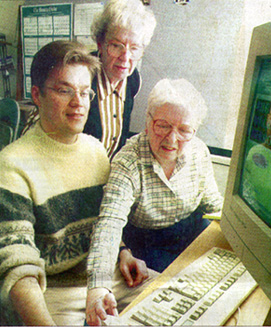Early Days
 The
SilverStringers project began in mid-1996. About ten volunteers from the Milano
Senior Center in Melrose, Massachusetts, met in March with representatives of
the MIT Media Laboratory who were part of the lab's News-in-the-Future Consortium.
They decided to take on a project that would involve a community-centric approach
to news in a variety of forms: written, photographic, graphical and audio. Only
two volunteers had experience with a computer; some had done some data processing
in their jobs; none had ever been connected to the internet, and two had done
some freelance writing.
The
SilverStringers project began in mid-1996. About ten volunteers from the Milano
Senior Center in Melrose, Massachusetts, met in March with representatives of
the MIT Media Laboratory who were part of the lab's News-in-the-Future Consortium.
They decided to take on a project that would involve a community-centric approach
to news in a variety of forms: written, photographic, graphical and audio. Only
two volunteers had experience with a computer; some had done some data processing
in their jobs; none had ever been connected to the internet, and two had done
some freelance writing.
Three desktop computers, a laptop computer, a scanner, a digital camera, and a color printer were installed at the Milano Senior Center for use by the first group of SilverStringers, who promptly launched The Melrose Mirror. Those who couldn't type were encouraged to write in longhand. Volunteers were found to retype onto disks or directly on the computer. In cases where a writer had a typewritten story, the material was scanned into the system. It was important to include everyone, whether or not they had any computer capability, particularly in the early stages.
After a few years the group has grown to more than thirty active members. Several have become proficient with computers and the SilverStringer software, and their Web-based publication draws readers from every part of the globe.